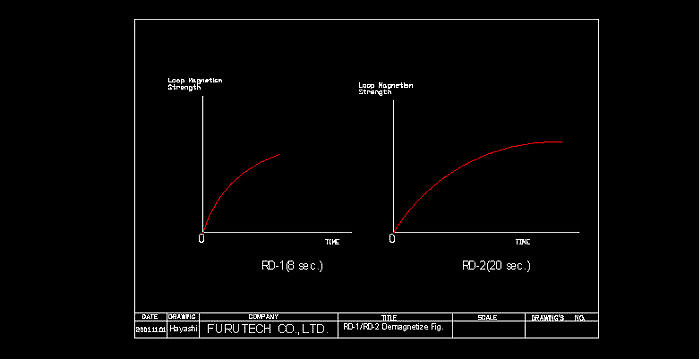|
Your audiophile friends in Japan
Last month, I wrote about the Furutech RD-1 CD/DVD degausser. Furutech has since released the RD-2 successor. It's a virtual look-alike - save for the fancier-colored silver plastic body. The only other overt change? The length of treatment - up from 8 seconds to now 20. Furutech's marketing director Frank Yoo explained. The expanded mag/demag cycle takes advantage of a beefed-up internal magnet that creates higher field strength for more powerful results. Distributor Jim Wang of Harmonic Technology added that the US retail for the RD-2 is $360. That's a small surcharge over the $299 for the RD-1. But it's less than the $399 the previous importer had originally anticipated. How often do promises of improvement in audio come at such a modest price increase?
Extrapolating from my earlier review, "unlike the Bedini which actively spins the CD over two beams, the Furutech... uses a powerful ring magnet. It first ramps up voltage to magnetize the CD resting stationary above, then reverses polarity to demagnetize the charge in what's referred to as a "loop ebbing" process...."
Rituals
Have you succumbed to 21st century instamatic point'n'shoot gratification? Then one minute of mystifying treatment downtime before you can play a disc may seem an unnecessary bother. Regardless, I'm here to tell you that this mini ritual of preparation -- getting at least marginally involved before hitting "play" -- won't hurt your audiophile sensibilities one bit, new millennium or not. Nay, it will clearly enhance your enjoyment and remind you of the co-creationist venture (recognized or unconscious) that deep listening always is or at least should be to skim profundity.
So what if you pay in transitory denomination - 40 fleeting passive seconds? All you're doing is watch the RD-2's green LED. First it lights up, then it slowly extinguishes while the canceling polarity charge fades. Flip the disc to treat the other side and note how anticipation about the impending listening session mounts. Good things are worth waiting for, eh?
That's it.
Truly, a puny effort compared to being a diehard vinylist. Can you see him sweating LP cleaning with soap, mold release or other fluids, flattening his treasures under tons of musty tomes, screwing with clamps or vacuum suction, VTA adjustments and unearthing the record from its sleeve without fingerprints to begin with?
Hey, I do you one better. If long-forgotten seditionist tendencies still stirred faintly in the depth of your rebellious soul, you could demagnetize the strip on your driver's license. The next police officer pulling you over for speeding would likely curse under his breath if he couldn't pull up your records and had to call in. Erasing a similarly blasted strip on your adolescent offspring's credit card won't prevent him from putting the hurt on your cosigned responsibilities, true - but at least it'll piss him off and earn you short-lived respect for unexpected deviousness.
But back to a more benevolent audiophile application: You can also curl up cables into the RD-2's well and treat 'em, or merely their metal terminals. This goes for power cord plugs, metal speaker jumpers, anything small enough to be exposed to the RD-2's field that could conceivably harbor a fugitive magnetic charge, however tiny.
|
|
|
|
 |
My original benefactor for the RD-1, Dave Sturdevant of Audio Persuasions in Juneau / Alaska, had long since asked for his unit back. When the RD-2 arrived, I no longer had it for a side-by-side comparison.
Then I birthed a pregnant thought. Since the complete treatment cycle is really a two-part charge/erase process, I should be able to test the extremes (between a fully magnetized disc and one fully destatic'd) by lifting the CD out of the RD-2 exactly 10 seconds into the cycle. Treat the flip side for an equally shortchanged measure of coitus interruptus and inspect the sonic ball buster.
This would -- repeatedly if necessary -- cause a worst-case scenario: A disc handicapped with a fully saturated magnetic charge. It should demonstrate how much sonic degradation disc magnetization can cause. I'd then run the whole cycle, play the same disc again and note -- or not -- the healing properties of the cure.
|
|
|
|
Magnetization is a maggot audible enough yet a small wee bugger at that
Starting off with "Parvaz" on the Axiom of Choice release Niya Yesh [Narada World, 72438-49289-2-6, 2000], the magnetically messed-with disc parlayed the tune as though it was temporally dragging its heels. It sounded slightly slower, the timing a bit hung up. It also sounded "smaller", with less body in Mamak Khadem's voice and Martin Tillman's con arco cello, this perhaps a function of marginally reduced output (the previous review includes graphs that indicate a 0.5dB post-treatment voltage gain). The gentle bass beats suffered a modest amount of boom with the 10-second treatment that disappeared after the full cycle.
These improvements were fine yet repeatable. They clearly belonged in the realm of gestalt, inflection and timing rather than grosser aberrations of frequency. Think of undusting a prehistoric skeleton with a brush. After a while, you know clearly what it is and can specify genus and gender. Yet removing further layers of fine chalk from the crevices of the bones adds detail. The mastodon remains the same mastodon. Someone not keen on taking a closer look at a long-dead fossil wouldn't appreciate the increase of depth that your prolonged dusting worked on its remains. But a proper archeologist would have an epiphany.
The superior demagnetized rendition was recognizable easiest by concentrating on the innate flow of the music. Did it feel halting and somewhat stagnant, as though pushing against a resistive force? Or did it flow freely and effortlessly, with a bit more exuberance and elegance?
Revisiting Jorge Cardoso's "Milonga" tango on Virtuosi by Gary Burton and Ozone Makoto [Concord, 2105-2, 2002] revealed more of the mechanical noises on Burton's vibraphone, the mallets' impacts followed by very crisp leading edges of both notes and production. By comparison, the maggot-ized disc gave the distinct -- and distinctly strange -- impression that Burton's notes were "sticking" to the metal bars and not lifting off properly.
After treating the disc for the full cycle, Ozone's turn to lead the melodic stomps of the tango on the piano moved as though with a heavier footfall, as though attacking his keys from a bit higher up for more impact. This difference played in the microdynamic arena where minor shifts in amplitude add life and expressiveness that have nothing to do with mere notes but how they're delivered. Overstated for effect, it's the difference between a programmed piano playing a tune and a life pianist injecting a goodly dose of personality.
   
For an affirmative test of dynamic enhancement, I now reached for the famous PopeMusic recording of Tchaikovsky's emotionally devastating orchestral testament, the "Pathétique" with Mark Gorenstein conducting the Russian Symphony Orchestra [Pope 1006-2, 1996]. With the already supercharged dynamic range embedded in this explosive recording, the very brisk rendition of the martial "Allegro Molto Vivace" instantly assumed an added jolt of intensity post-treatment. This was apparent already in the very first woodwind segment following the opening string staccatos. They were distinctly louder than the strings, more so than before.
Needless to say, once the blasting brass and thunderous tympani joined the chorus, things got rather scarier in terms of dynamic contrast, especially on the drum whacks. In this instance, I had compared a CD pulled out of its jewel case against the fully treated version, presumably dilulting differentation over first hitting it with my focussed 10 sec. charge. The verdict of this encounter? Definite plastic surgery enhancement of dynamic curvature. Here it was made all the more obvious due to the genetic advantage of a recording specifically catering to immense dynamic scope already.
What kind of improvements could one expect from a less-than-stellar recorded Pop album, of music one adores regardless of audiophile concerns? For whatever reason, I'm very fond of Turkish Pop and its reigning diva Sezen Aksu. But there are others like Ibrahim Tatlises, Levent Yüksel, Burhan Cacan and Tarkan no less enjoyable if perhaps not quite as sophisticated. My latest personal discovery in this field? Esra Özmen and certain cuts on her album Tutus [Kiss Müzik], like "Bir Rüya" and "Isterse Kovsun". What passionate delivery, what a husky alto voice!
And - less post-op flinching when Esra scaled her upper registers and let 'er rip. It's this kind of slightly uncontrolled vocal risk taking and "going for it" that gives me prized goosebumps. Still, merely moderate production values often inflict a dose of aural pain during such pleasures - a certain glare with female vocals especially at higher volumes. The demagnetization made things rather more palatable. Whatever pain was left receded into the background not to be noticed if it was still present.
Is 2 better than 1?
You get the picture. The RD effects are not earthshaking - like getting a new speaker with lower bass or a more refined and extended tweeter. No, they're more along the lines of going from good digital to digital that's slightly better. There are delicate, at times elusive refinements. But the flip side in digital these days? An often rather disproportionate dump of funds. Your better half (external or internal) may proclaim doing something about those refinements hazardous to your health or relationship.
However, the RD-2 only sets you back $360. That buys you a decent DVD player, true. On the face of it, that's a rather more substantial purchase, one that surely has to come first. But - going from a decent DVD or CD player to one significantly superior when you close your eyes will likely cost quite a bit more than double if you started out with $400. Getting the RD-2 may be the less painful route for similar improvements, especially if there's nothing wrong with your digital source component to warrant even thinking about replacing it.
In the context of a resolved system owned by keen ears, I find the Furutech demagnetizer well worth the asking price. In fact, I consider it the concluding part of a mandatory two-pronged approach to CD prep, the other being an occasional application of Walker Audio's Vivid optical enhancer. Incidentally, Furutech makes its own enzyme-based PC-2 CD cleaning fluid. Combining physical cleansing with electromagnetic de-ghosting should be considered one of those crowning touches that complete the picture -- er, sound -- of a cared-for system. In fact, it'd probably improve the picture of a video system just as much if not more, 'cept I'm the wrong guy to comment. Heathen that I am, I don't own no stinkin' DVD player.

By way of documenting the difference in loop magnet strength between the RD-1 (left) and RD-2 (right), Frank Yoo sent along this graph.
Now, is the RD-2 better than its predecessor? How would I know? Even though barely a moon has passed, I already feel less than confident to say based on pure memory. I'll cheat then. Why would a company bother with the expenditure of time, money and energy to create a MkII iteration of something that retails for a mere 20% more than its predecessor? The actual net profit increase for the firm couldn't be more than 10%, surely not an indicator of greed.
No, considering the care taken with the RD-2 and already in-house RTP-6 -- as well as perusing their website's other offerings -- I'm left with a distinct impression. Furutech is in it for the love of music; for perfecting our enjoyment of it with thoughtful accouterments that optimize the workings of the essentials with purpose-engineered power i/o ports, proper earthing boxes, room treatments, software treatments, connectors and cables.
Now you'll understand the very first paragraph header farther up. We have some well-meaning and very talented friends in faraway Japan that make good stuff for not a lot of money; friends indeed. Stay tuned then for more furutekkie stuff coming soon!
|








